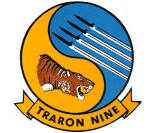Training Squadron NINE
 Training Squadron NINE was commissioned on December 15, 1961 at McCain Field, U.S. Naval Air Station, Meridian, Mississippi. It is the third Naval squadron to be designated VT-9. The first VT-9 was commissioned in 1927 as a Torpedo Squadron, flying the Curtis T3-M Convertible Land/Seaplane. On August 2, 1971, VT-9 "Tigers" branched off to form its "sister" squadron designated VT-19 "Frogs", and both squadrons assumed the intermediate jet training role at Meridian. Training Squadron NINE was decommissioned in July 1987 and consolidated with Training Squadron NINETEEN. Training Squadron NINETEEN was redesignated Training Squadron NINE, 01 October 1998, and the "Tigers" were again reborn.
Training Squadron NINE was commissioned on December 15, 1961 at McCain Field, U.S. Naval Air Station, Meridian, Mississippi. It is the third Naval squadron to be designated VT-9. The first VT-9 was commissioned in 1927 as a Torpedo Squadron, flying the Curtis T3-M Convertible Land/Seaplane. On August 2, 1971, VT-9 "Tigers" branched off to form its "sister" squadron designated VT-19 "Frogs", and both squadrons assumed the intermediate jet training role at Meridian. Training Squadron NINE was decommissioned in July 1987 and consolidated with Training Squadron NINETEEN. Training Squadron NINETEEN was redesignated Training Squadron NINE, 01 October 1998, and the "Tigers" were again reborn.
The mission of VT-9 is to safely train the world's finest Naval Aviators for the United States and other international Navies in Intermediate Strike and Advanced E2/C2 training. International Student training has consisted of pilots for the Navies of Spain, France, Italy, Thailand, and also Kuwait's Air Force.
Training Squadron NINE is the only U.S. Navy pilot training squadron that operates the Rockwell T-2C "Buckeye" to accomplish its mission. A civilian maintenance contractor maintains the 78 T-2C aircraft flown by VT-9. Loral Aerospace Corporation operates T-2C flight simulators.
Student Naval Aviators and International Military Students are aboard VT-9 for approximately four to six months and are trained in many fundamental skill stages of strike and carrier aviation. Initially, students fly several instrument flights focused on building a solid flight foundation for instrument scan. Sixteen day and four night flights are then devoted to the familiarization stage where students learn basic aircraft maneuvering, aerobatics, and carrier landing skills. The next stage in training is fifteen formation flights in two and four plane formations laying the foundation for tactical flying. Students then progress to eight air-to-air gunnery flights designed to develop the students' dynamic maneuvering flight abilities and situational awareness. Finally, ten sorties closely controlled by a Landing Signal Officer, culminate in a landing field qualification that designates the individual safe to train on an aircraft carrier. About 24 percent of VT-9 students are trained in the Advanced E-2/C-2 phase curriculum. For these students, the Air-to-Air Gunnery stage listed above is replaced by Carrier Qualification at-sea, including four touch and go landings and ten aircraft carrier arrested landings.
Upon successful completion of training at Training Squadron NINE, the E-2/C-2 students receive their coveted "Wings of Gold" and are transferred to the Fleet Replacement Squadron. The basic jet students move on to Advanced Strike Training in the McDonnell Douglas T-45 "Goshawk" where the Student Naval Aviators receive additional instruction in Air Combat maneuvering, Weaponry, and aircraft carrier landing qualification.
Training Squadron NINE's record of achievement has culminated in five Chief of Naval Operations, Aviation Safety Awards over the years for sustaining an unprecedented safety record. The squadron was recently awarded the 1998 CNATRA Training Excellence Award. Training Squadron NINE's other awards include two Secretary of the Navy "Meritorious Unit Commendation" awards in recognition of exceeding the established goals of safety, quality, and projected training rates.
|
NEWSLETTER
|
| Join the GlobalSecurity.org mailing list |
|
|
|

